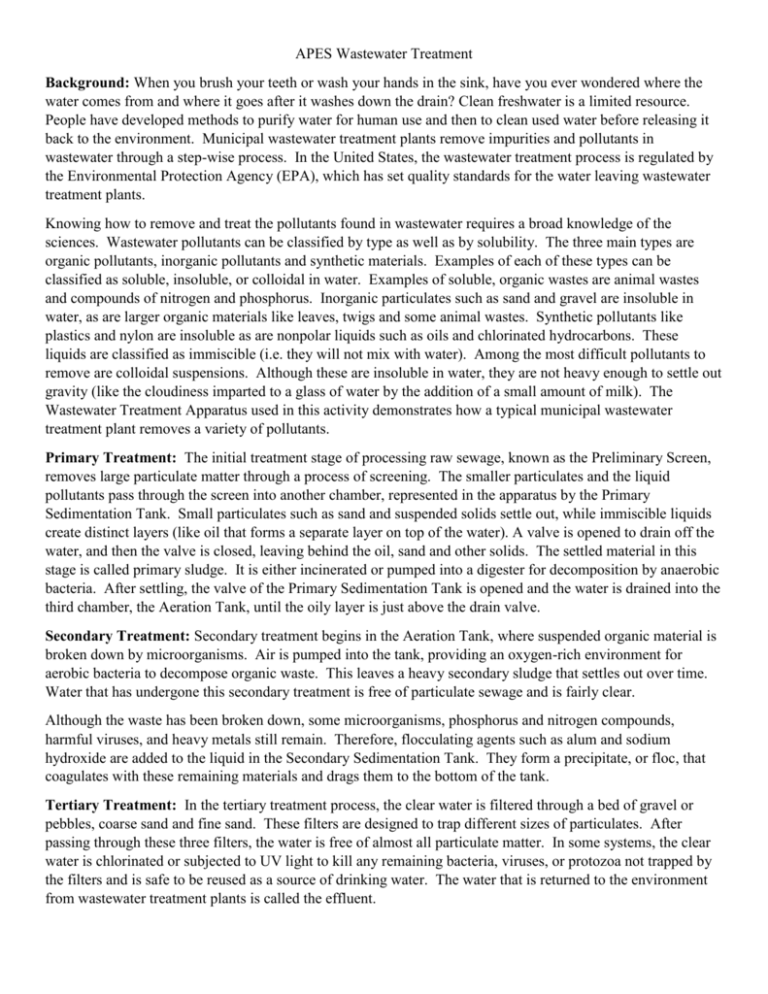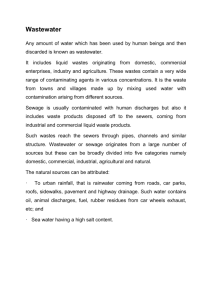Wastewater Treatment Lab Day 1
advertisement

APES Wastewater Treatment Background: When you brush your teeth or wash your hands in the sink, have you ever wondered where the water comes from and where it goes after it washes down the drain? Clean freshwater is a limited resource. People have developed methods to purify water for human use and then to clean used water before releasing it back to the environment. Municipal wastewater treatment plants remove impurities and pollutants in wastewater through a step-wise process. In the United States, the wastewater treatment process is regulated by the Environmental Protection Agency (EPA), which has set quality standards for the water leaving wastewater treatment plants. Knowing how to remove and treat the pollutants found in wastewater requires a broad knowledge of the sciences. Wastewater pollutants can be classified by type as well as by solubility. The three main types are organic pollutants, inorganic pollutants and synthetic materials. Examples of each of these types can be classified as soluble, insoluble, or colloidal in water. Examples of soluble, organic wastes are animal wastes and compounds of nitrogen and phosphorus. Inorganic particulates such as sand and gravel are insoluble in water, as are larger organic materials like leaves, twigs and some animal wastes. Synthetic pollutants like plastics and nylon are insoluble as are nonpolar liquids such as oils and chlorinated hydrocarbons. These liquids are classified as immiscible (i.e. they will not mix with water). Among the most difficult pollutants to remove are colloidal suspensions. Although these are insoluble in water, they are not heavy enough to settle out gravity (like the cloudiness imparted to a glass of water by the addition of a small amount of milk). The Wastewater Treatment Apparatus used in this activity demonstrates how a typical municipal wastewater treatment plant removes a variety of pollutants. Primary Treatment: The initial treatment stage of processing raw sewage, known as the Preliminary Screen, removes large particulate matter through a process of screening. The smaller particulates and the liquid pollutants pass through the screen into another chamber, represented in the apparatus by the Primary Sedimentation Tank. Small particulates such as sand and suspended solids settle out, while immiscible liquids create distinct layers (like oil that forms a separate layer on top of the water). A valve is opened to drain off the water, and then the valve is closed, leaving behind the oil, sand and other solids. The settled material in this stage is called primary sludge. It is either incinerated or pumped into a digester for decomposition by anaerobic bacteria. After settling, the valve of the Primary Sedimentation Tank is opened and the water is drained into the third chamber, the Aeration Tank, until the oily layer is just above the drain valve. Secondary Treatment: Secondary treatment begins in the Aeration Tank, where suspended organic material is broken down by microorganisms. Air is pumped into the tank, providing an oxygen-rich environment for aerobic bacteria to decompose organic waste. This leaves a heavy secondary sludge that settles out over time. Water that has undergone this secondary treatment is free of particulate sewage and is fairly clear. Although the waste has been broken down, some microorganisms, phosphorus and nitrogen compounds, harmful viruses, and heavy metals still remain. Therefore, flocculating agents such as alum and sodium hydroxide are added to the liquid in the Secondary Sedimentation Tank. They form a precipitate, or floc, that coagulates with these remaining materials and drags them to the bottom of the tank. Tertiary Treatment: In the tertiary treatment process, the clear water is filtered through a bed of gravel or pebbles, coarse sand and fine sand. These filters are designed to trap different sizes of particulates. After passing through these three filters, the water is free of almost all particulate matter. In some systems, the clear water is chlorinated or subjected to UV light to kill any remaining bacteria, viruses, or protozoa not trapped by the filters and is safe to be reused as a source of drinking water. The water that is returned to the environment from wastewater treatment plants is called the effluent. Wastewater Treatment in the U.S.: Not every wastewater treatment plant uses all three stages of treatment. Every 4 years, the U.S. EPA conducts a Clean Water Needs Survey and analyzes the data, tracking progress in municipal wastewater treatment. In 2008 there were 14,770 publicly owned wastewater treatment facilities in operation, serving about 74% of the U.S. population-more than 226 million people. Of those facilities, 30 stopped short of secondary treatment; 7, 302 used both primary and secondary treatments; 5, 072 used some form of tertiary treatment. More than 2, 200 of the facilities were categorized as no-discharge facilities— essentially, releasing no pollutants. The trend toward more rigorous treatment and the release of cleaner effluent continues. Pre-lab Questions (Answer in your field notebook!): 1. What do wastewater treatment plants use to kill viruses, bacteria and other microorganisms in wastewater? 2. How would a wastewater treatment plant that utilizes only primary treatment differ from one that utilizes both primary treatment and secondary treatment? Materials: Portable air pump with tubing and airstone Plastic pinch clamps Glucose test strips Simulated wastewater Alum solution Sodium hydroxide solution Wastewater treatment apparatus Graduated cylinder Activated yeast solution Procedure: Activity 1: Primary Treatment-Preliminary Screen and Primary Sedimentation Tank 1. Pour 260 mL of simulated wastewater (containing glucose, sand, beads and vegetable oil) into the top tank. After a few minutes of settling, the solution should form three distinct layers. 2. Slowly open the pinch clamp of the Primary Sedimentation Tank, allowing the solution to drain into the Aeration Tank. Close off the clamp just before the upper, oily layer reaches the spout. Activity 2: Secondary Treatment-Aeration Tank 1. Connect the airline tubing to the air pump. Attach the airstone to the airline tubing and place the airstone in the bottom of the Aeration Tank. Turn on the pump and begin aerating the solution. 2. Create a data table to record the concentration of glucose over time. Sample the wastewater with glucose test strips every 5 minutes for the first 20 minutes, then every 10 minutes for a total of 50 minutes. 3. To measure the amount of glucose, dip the indicator pad of the test strip into the simulated wastewater for a few seconds. Remove the strip, shake off the excess water and wait 3 minutes for the color to develop. Match the color of the pad with the chart on the test strip bag. 4. While the air pump continues to aerate the simulated wastewater, pour 50 mL of yeast into the Aeration Tank. Record the time elapsed from the moment that the microorganisms are introduced into the tank. Record the time and concentration information on your data table. 5. Create a graph to plot the data from your data table. Note: During any down time, answer the analysis questions related to the specific activity. Activity 3: Secondary Treatment-Secondary Sedimentation Tank 1. Open the valve of the Aeration Tank and allow the simulated wastewater to drain into the Secondary Sedimentation Tank. 2. In the Secondary Sedimentation Tank, heavier particles will settle after a few minutes, but some solids remain in colloidal suspension (insoluble in water but not heavy enough to settle out by gravity). 3. To remove the suspended solids, add 30 mL of 0.1 sodium hydroxide to the secondary sedimentation tank. Then, add 90 mL of the stock alum solution. 4. Simulate “flash mixing” by rapidly stirring the solution with a spoon or stirring rod for 30 seconds. Then, allow the mixture to form a heavy floc or precipitate. This floc drags down suspended solids within 10 minutes, leaving relatively clear water above. -Let the tank sit overnight to allow for complete sedimentation. See Mrs. Blanks for the other assignment for the day.5. Drain off the liquid in the tank into a beaker for observation. Questions (Complete in your field notebook!) 1. List the materials that were removed during each step of the treatment process. 2. Identify the three distinct layers that formed in the Primary Sedimentation Tank. 3. After the Primary Sedimentation Tank valve was closed, what pollutant(s) remained in the tank? Which had passed into the Aeration Tank? 4. What is the purpose of the Aeration Tank? What happens in this tank? 5. Classify each of the treatment steps as a physical, chemical or biological method of pollutant removal (or some combination of methods). 6. Based upon your graph of pollutant concentration over time, identify the independent and dependent variables. What is the mathematical relationship between these two variables? 7. If a body of water is odorless and clear, is it therefore safe to drink? Explain your answer. 8. What are some uses for the partially treated water represented by this simulation? 9. Suppose there is a regulation that states that water released from the wastewater treatment must have a glucose concentration of <100 mg/dL. Does the model wastewater treatment plant currently meet the regulation? What is one way that the glucose concentration could be further reduced? 10. Fecal coliforms, bacteria normally found in feces, are considered an indicator of potentially pathogenic microbes present in wastewater effluent. A municipal wastewater treatment plant (WWTP) releases treated water into a local stream. Fecal coliform tests were conducted in a local stream at one location upstream and multiple locations downstream of the discharge point. The test results represent the number of fecal coliform colony-forming units (CFU) per 100 mL of water collected, presented in the table below. Use the data table to answer the following questions. Distance downstream of WWTP (km) Fecal Coliform test results (CFU/100 mL) -1 170 0 1620 1 1780 5 830 10 370 15 180 20 200 a. Construct a graph to demonstrate the relationship between the fecal coliform test results and the distance downstream from the wastewater treatment plant. b. Explain why the coliform count is highest 1 kilometer downstream of the wastewater treatment plant, and then decreases further downstream. c. The state’s established limits for fecal coliform state that the fecal coliform in waters should not exceed 1000 CFU/100 mL. What recommendations would you make to the WWTP to reduce the amount of fecal coliform during water treatment?








